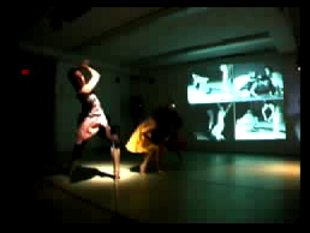24.
Dischord (2001)
 a dynamic installation for three dancers with motion-density controlled composite video, computer music mediated by laser beam-breakers and an optional live berimbau player.
a dynamic installation for three dancers with motion-density controlled composite video, computer music mediated by laser beam-breakers and an optional live berimbau player.
The music for Dischord is a piece of Musique Concrète, projected by a quadraphonic sound system and realized in real-time by an algorithm programmed with the MAX/MSP environment.
What you hear is the interaction of five (or optionally six) constituent sound elements:
- Three collections of concrete sounds, each corresponding to a specific dancer and to one of the three areas tracked by laser beam-breakers. Each layer is assigned to a fixed stereo position within the quadraphonic spread range. The three collections are:
- train station sounds, wind and rain sounds, muslim call to prayer, choir of human voices ;
- car engines failing to start, screech of car tires and car crash, street drill, glass breaking, door noises, pigmy chant played backwards ;
- footsteps, a woman's sighs and vocalizations, cabaret music ;
- An assortment of African drums (Burundi war drums, Nubian drums from Egypt and Gnawa music from Morocco) arranged in twelve groups of patterns. The drums are played through moving positions inside the quadraphonic spread range.
- Sixteen bells, tuned to a micro tonal scale based on the proportion of 1.038566, an addition of 65.5113 midicents. The bells are also played through moving positions inside the quadraphonic spread range.
- A live contact-miked berimbau player can figure as an optional additional element. If present, the berimbau part presents improvised patterns of brazilian rhythms. The berimbau sounds are processed by ring-modulation in real-time and mixed together with the other sounds in different positions inside the quadraphonic spread range.
The MAX/MSP program responds to stimuli from the dancers as they cross the system of three laser beam-breakers positioned on stage. By crossing a beam breaker, a dancer influences the density (rate of the appearance) of the concrete sounds of the collection associated to that particular beam-breaker. When two of the beam-breakers are crossed simultaneously, one bell sound is played at a random location. When the three beam-breakers are crossed simultaneously, an arpeggiated chord of three to seven bells is played. The comparison between the densities of the three layers of concrete sounds and the density of the bells yields changes in the drum patterns.
music and music software: Marcus Bittencourt
hardware: Michael Prerau
coreography and dance: Leah Nelson, Colleen O'Meara, Dana Ruttenberg
visuals and video: David Sun
Recording, without the berimbau player:
Video of the 2001 performance, Prentis Hall, Columbia University, New York, USA: